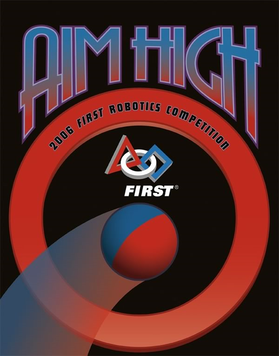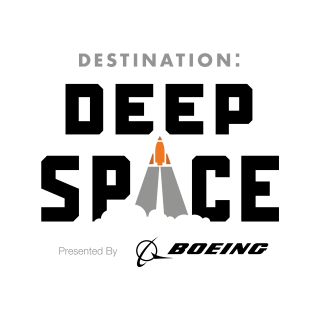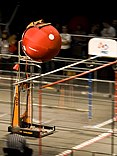
FIRST Frenzy: Raising the Bar was the 2004 game for the FIRST Robotics Competition. The game included elements from previous years' games, including mobile goals, "capping" goals with large inflatable balls, and others. In Raising the Bar, teams could score by having their human player score purple balls in any of the goals, capping the goals with a multiplier ball, or hanging their robot suspended from the 10-foot (3.0 m) high 'chin up bar'. In the qualifying matches, Teams competed in 2-member randomly generated alliances. In the elimination rounds, 3-member alliances competed against each other with one team sitting out each match. The alliance that won two matches advanced in the tournament.

Aim High was the 2006 game for the FIRST Robotics Competition. The competition involved teams competing to gain points by delivering balls into goals and positioning their robots in certain positions on the playing field. The teams took it in turn to provide defense and attack.

Triple Play was the name of the 2005 season FIRST Robotics Competition game.

Rack 'n Roll was the game for the 2007 FIRST Robotics Competition season, announced on January 6, 2007. In it, two alliances of three teams each competed to arrange ring-shaped game pieces on a central arena element known as 'The Rack'.

FIRST Overdrive was the 2008 game for the FIRST Robotics Competition, announced on January 5, 2008. In it, teams competed to complete counterclockwise laps around a central barrier while manipulating large 40 in (1 m) diameter "Trackballs" over and under overpasses to score additional points.

Lunacy is the game for the 2009 FIRST Robotics Competition. Announced on January 3, 2009, the name and some of the features of the game honor the 40th anniversary of the first human mission to the Moon. It is FRC's 18th game. This is the first FRC competition to use the cRIO Mobile Device Controller control system from National Instruments. The driver station introduced for 2009 was the Kwikbyte DS, which was replaced in 2010 by the Classmate PC.
Breakaway is the game for the 2010 FIRST Robotics Competition, announced on January 9, 2010. Robots direct soccer balls into goals, traverse "bumps" in the field, suspend themselves and each other on towers, and/or go through a tunnel located in the center of the field.

Logo Motion is the 2011 FIRST Robotics Competition game. Playing pieces are inner tubes shaped like the components of the FIRST logo. The primary objective of the game is to place them on racks to gain points. In the endgame, robots deploy smaller robots ("minibots") to climb a tower. Minibots must be made from the FIRST Tech Challenge kit of parts. The game celebrates the 20th season of the FRC and is also meant to commemorate the artist Jack Kamen, who designed the original FIRST logo.

Bowled Over!, released on 10 September 2011, is the 2011–12 robotics competition for FIRST Tech Challenge. Two alliances compete to score racquetballs into alliance-colored scoring goals. The name refers to two bowling balls on the field used for scoring points.

Ring It Up!, released on 8 September 2012, was the 2012–2013 robotics competition for FIRST Tech Challenge. In the competition, two alliances, each consisting of two teams, competed to score plastic rings on a set of pegs aligned in a three-dimensional tic-tac-toe board. Ring It Up! is the eighth FTC challenge. More than 2400 teams competed worldwide, surpassing the number of competitors in the previous year's Bowled Over! challenge.

Ultimate Ascent was the 2013 FIRST Robotics Competition game. It is styled similarly to disc golf.

Block Party!, released on September 7, 2013, is the 2013–2014 robotics competition for FIRST Tech Challenge. In the competition, two alliances, each consisting of two teams, compete to score blocks in plastic crates atop alliance-colored pendulums. Block Party! is the ninth FTC challenge.

Recycle Rush was the 2015 FIRST Robotics Competition game. It involves picking up and stacking totes on scoring platforms, putting pool noodles ("litter") inside recycling containers, and putting the containers on top of scoring stacks of totes. There is also a coopertition aspect of the game where both alliances of teams can pool their totes and stack them on a step dividing the field to each gain twenty points. Along with these robot actions, human players can attempt to throw the pool noodles across the field to gain four points for each noodle left in the opposing alliance's work zone.
FIRST Stronghold was the 2016 FIRST Robotics Competition game. The game was played by two alliances of up to three teams each, and involves breaching the opponents’ defenses, known as outer work as well as capturing their tower by first firing "boulders" at it, and then surrounding or scaling the tower using a singular rung on the tower wall. Points were scored by crossing elements of the tower's outer works, shooting boulders into the opposing tower's five goals in order to lower the tower strength, and by surrounding and scaling the tower.
VEX Robotics is a robotics program for elementary through university students, and a subset of Innovation First International. The VEX Robotics competitions and programs are managed by the Robotics Education and Competition Foundation (RECF). In April 2018, VEX Robotics Competition was named the largest robotics competition in the world by Guinness World Records.

FIRST Steamworks, stylized as FIRST STEAMworks, was the FIRST Robotics Competition game for the 2017 season. As in past games, two alliances of three individual teams and their robots compete on a field to score "match" point to win the game and ranking points to advance to playoff rounds. The game has a steampunk theme and teams are required to shoot wiffle balls which represent fuel into a simulated boiler which transfers the generated steam into an airship in the middle of the field. Each alliance has one airship, which they pressurize with steam from the boiler and load with plastic gears from the field. At the end of the match, robots can climb and hang on team-supplied ropes attached to the airship for additional points.

FIRST Power Up, stylised as FIRST POWER UP, is the FIRST Robotics Competition game for the 2018 season. It involves two alliances of three teams each, with each team controlling a robot and performing specific tasks on a field to score points. The game has a retro 8-bit theme and teams are required to place milk crates, or "power cubes", on large balancing scales to tip the scale and gain ownership. Alliances can also trade power cubes for power ups, giving them a temporary advantage in a match. At the end of the match, robots can climb the tower attached to the centre balancing scale using a rung attached to the tower, giving them additional points.

Destination: Deep Space, stylized as DESTINATION: DEEP SPACE and officially known as Destination: Deep Space Presented By The Boeing Company, is the FIRST Robotics Competition game for the 2019 season. It involves two alliances of three teams each, with each team controlling a robot and performing specific tasks on a field to score points. The game centers around an outer space theme involving two alliances consisting of three teams each competing to place poly-carbonate hatch panels and orange rubber balls or "cargo" on rockets and cargo ships before returning to their HAB platform to climb at the end of the match.

Rapid React, stylized as RAPID REACT and officially known as Rapid React presented by The Boeing Company for sponsorship reasons, is the FIRST Robotics Competition (FRC) game for the 2022 season. The game is themed around transportation as part of the FIRST-wide FIRST Forward theme for 2021-2022.

Charged Up, stylized as CHARGED UP and officially known as Charged Up presented by Haas for sponsorship reasons, is the FIRST Robotics Competition game for the 2023 season. The game is part of the FIRST-wide FIRST Energize theme for the 2022-2023 season, which focuses on energy and sustainable development. The season's kickoff event occurred on January 7, 2023, and was streamed live on Twitch.



















